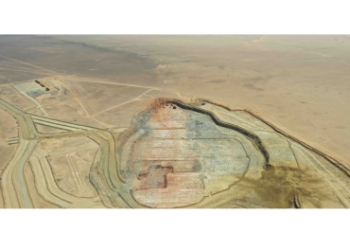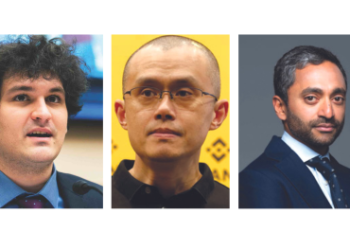Sensing, Coping and Creative Thinking for Leaders
Words Deepal Sooriyaarachchi.
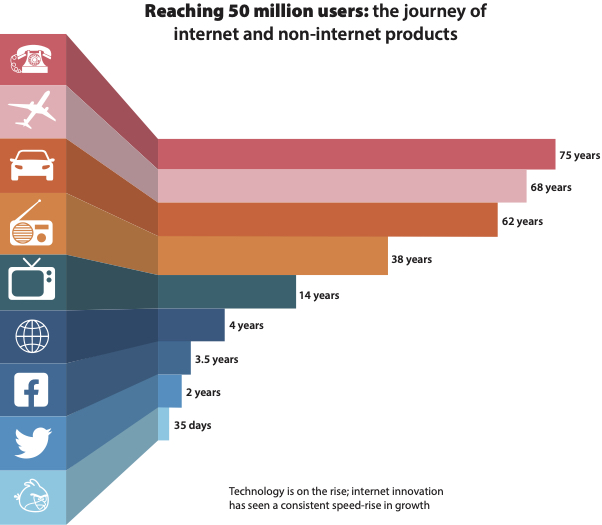
“The only permanent thing in life is change.” This is a quote we often hear. In the context of organizations, we need to be aware of two types of changes. One is changes within the organization, and the other is changes in the operating environment. If the change in the operating environment is faster and more significant than the changes within the organization, then extinction is inevitable. Business history is full of such instances. Thus, the phrase “you cannot see dinosaurs dance” is used.
If one observes the changes that have taken place in the past few decades, it becomes very clear that the speed of change and the intensity of the change in almost all areas of human existence have been fast and vast. Whether it is technology, other fields of science, political and economic dimensions, or even climatic conditions, they have been changing dramatically and at shorter intervals. In every sphere, the cycles of change have become shorter and the intensity sharper.
To illustrate this, we can take the time to reach 50 million users of various technologies, pre-internet and post-internet. Even if the data are not 100% accurate, we have observed these trends as contemporary phenomena. These changes have impacted the operating environment of businesses significantly.
All leaders must excel at personal proficiency. Without the foundation of trust and credibility, you cannot ask others to follow you.
Businesses cannot use the management paradigm when the changes are so severe. Managing according to rules can work well when there is predictability. When that is not there, the organizations have to adapt very quickly to the changing environment, anticipate such changes, and effect appropriate changes within the organization. This can be done only by leading.Over the last two decades, leadership has become a significant area of study and training in the corporate world. According to a Forbes article published in 2020 alone, leadership development has been a $366 billion industry worldwide. The number of books written about leadership, too, is testimony to this observation.A landmark study by Prof. Dave Ulrich, Norm Smallwood, and Kate Sweetman offered a simplified formula known as the Leadership Code.The Leadership Code is the result of extensive research done by the world-renowned HR Guru Dave Ulrich et al. to synthesize the core capabilities of leaders based on all the significant research and practical work available up to that time. This helps anyone cut through the concept of clutter and identify what every leader at whatever level of the organization must do and be. Thus, the five leadership roles are identified as: strategist, executor, talent manager, and human capital developer, with the core being personal proficiency. The Leadership Code helps every leader link their results to these capabilities.Simply put, they are strategists. Where are we going? Executor: How are we going and what needs to be done? Talent Manager: Who comes with us? Human Capital Developer: Who will be there when we are gone? Then, the core is a set of personal competencies. They are summarized as personal proficiency.
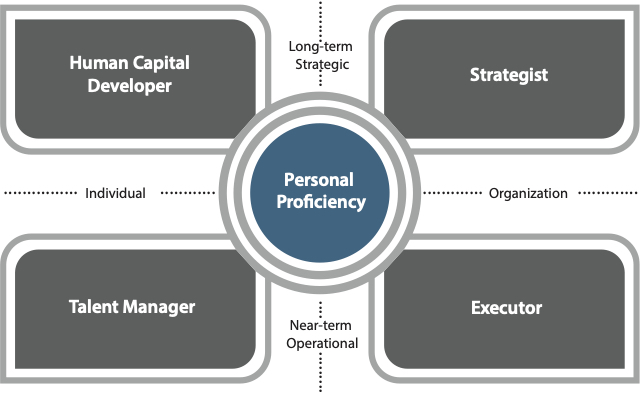
Leadership Code
The authors have made some broad observations over the years. All leaders must excel at personal proficiency.
Without the foundation of trust and credibility, you cannot ask others to follow you. While individuals may have different styles (introvert/extrovert, intuitive/sensing), any leader must be seen as having personal proficiency to engage followers. This is the toughest of the five domains to train; some individuals are naturally more capable than others. All leaders must have one towering strength. Most successful leaders have at least one of the other four roles in which they excel. Most are personally predisposed to one of the four areas. These are the signature strengths of your leaders.All leaders must be at least average in their “weaker” leadership domains. Training someone to learn how to be strategic, execute, manage talent, and develop future talent is possible.
There are behaviors and skills in each domain that can be identified, developed, and mastered. The higher up the organization that the leader rises, the more they need to develop excellence in more than one of the four domains. In the current context of an ever-increasing digitized civilization, leaders must pay more attention to three of the many proficiencies identified under Personal Proficiency. They are the ability to cope, think creatively, and enhance the ability to sense.
Ability to Cope
When changes are frequent and dramatic, leaders are exposed to increasing moments of uncertainty. A leader must navigate such uncertainties to move forward; this can be compared to the fundamental human behavior of walking. If you walk very slowly, paying attention to the movement of your feet and the sensations, you will notice that to move forward, one has to lift one foot, move it forward, and bring that to the ground. The other foot must be raised from the floor as it touches the ground. Between touching the first foot and raising the other foot, one goes through a moment of imbalance when the entire body weight is transferred to the leg in contact with the ground. But walking happens because the person is sure of the landing surface, the floor, and the sense of direction of the movement. Even more than the ground’s firmness, the importance of direction helps us move.From this simple process, we can understand one of the fundamental dimensions of uncertainty and how to cope. That is, to develop confidence in what you are doing and have a clear sense of direction, although the present moment is lucid and in turmoil.
When a leader must navigate so much uncertainty, it takes a heavy toll on her; this can be stressful. In such situations, the leader should be able to show kindness or friendliness toward oneself. If you want to demand more performance, you must be kind to yourself and provide as much positive energy as possible. Even if mistakes happen, you should not punish yourself. The best approach, I think, is to imagine “you as your child.” Treat yourself in the same way as you would treat your child in difficult situations. When faltering, how will a caring parent behave toward a child? If that is the attitude the leader has for herself, then the same attitude will touch the fellow team members, ensuring closer cooperation.This capability can be developed by learning to have increased self-awareness.
Thinking Creatively
This is identified as intellectual agility within the Leadership Code under personal proficiency. In all fields, the ability to be creative will be significantly higher with the advent of AI. This applies to all areas, whether science, the arts, or commerce. To illustrate this phenomenon, let me take marketing communications as an example.
Two or three decades ago, creativity in marketing communications depended on individual art or copy directors based on their exposure and circumstances. Later, as the circulation of international publications increased, exposure enhanced, and collective creativity was positively influenced. This can be seen if one studies the evolution of print ads over the last four to five decades. In the sphere of Television Commercials, satellite TV allowed cross-border TV commercials to be seen by creative directors in many markets. This exposure improved the overall creative quality of TV commercials as talent shows like “Got Talent” enhanced the quality and creativity of performing arts.The popularity of social media changed the dynamics completely, as many could create and co-create each other’s work. Again, the complexity of overall creativity enhanced significantly.In all these stages, an individual artist gets exposure that conditions the overall creative standards. However, AI synergizes and synthesizes millions of expressions, forming a new wave of creativity far more profound than all the previous waves of collective creativity enhancements. This demands that the leaders leverage that collective creativity and be even more creative. To improve creativity, a leader should master five basic behaviors known as the DNA of the Innovator (Prof Hal B. Gregersen). They can observe, question, experiment, network, and associate thinking.
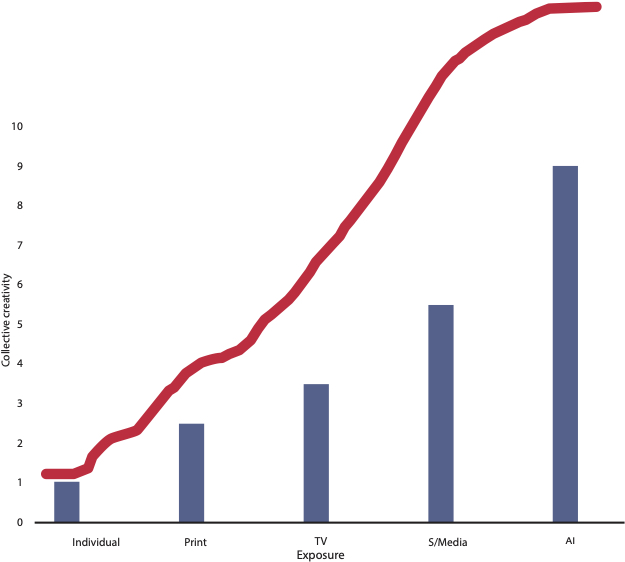
Sensing
Sensing is a living organism’s ability to read the environment and the beings present around it and respond appropriately. This, as you can appreciate, is a basic survival instinct if not a capability. However, with the advancement of technology, we are becoming increasingly poorer in sensing as a species.Five decades ago, farmers in tropical Asian countries could predict the weather by observing different environmental phenomena. For instance, if they noticed the weaver birds build their nests in higher branches, they knew they could expect heavy rains. If they build their nests in lower branches, then that indicates poor rainfall during the forthcoming season. When you think of it, doesn’t that make sense? If the rain is heavy, there can be floods, and to face floods, the nests must be on higher branches. Those farmers observed what happened around them so carefully that they could observe the trends and patterns and build those into their knowledge base.
Today, while Google Maps makes everyone confident enough to travel even to unknown locations, it takes away the ability to notice landmarks. A very important sensing capability. Similarly, business leaders must sense the constant changes that are taking place in the operating environment by observing trends and patterns, not only with the help of predictive analytics but with human intuition as well. In addition, leaders need to be sensitive to themselves, understanding their deep emotions and motives, to perform better. When a person is sensitive to themselves, they can observe, listen, and empathize with the person next to them. This is very important as we are increasingly becoming lonely, and the ability to communicate with fellow human beings by looking into their eyes and understanding their feelings is becoming weaker. The leaders must be better at it if they are to link with the team members. To develop these three capabilities of coping, thinking creatively, and sensing oneself and the environment, one must be more and more self-aware. Becoming aware is an essential human capability that can be developed into a refined skill through mindfulness, or sati, as described in the Buddha’s teachings. However, the practice itself has no religious limitations. We have a general capacity to become aware of our surroundings. We become aware of our actions sometimes long after an event, as we are engaged halfway through, and sometimes just before. We can be more mindful if this basic capability is developed through constant conscious practice.
When we are mindful, we learn to become intensely aware of the present moment. Especially life as it happens now. Bringing our attention to the present, free from the worries of the past and the anxieties of the future, are the two main distractions from the present moment. This reduces the inner chatter and develops a profound silence for pro-longed periods. This alone frees up an enormous amount of mental energy wasted dwelling on the past and the future. Secondly, this skill helps us observe things without losing perspective and becomes increasingly sharp in our observations. We lose our ability to observe objectively because our likes or dislikes or deluded or confused mental states always influence us. Mindfulness gives a person the edge to approach situations with a clear and calm mind—the essential ingredient to navigate through the stressful situations we are exposed to regularly. As a technique, observing any physical sensations as they occur, movements of the body, and even becoming aware of mental states is recommended. It is expected to observe the movement of the breath without interfering with it. In doing so, whenever the practitioner realizes that her attention is not on the breath but on some other stimuli or a thought, she becomes aware and brings the attention back to her breath. While doing that, she develops this very important capability of “letting go,” which is the fundamental prerequisite for mental freedom. It is only a mind that knows to be free can Cope uncertainties, allow creativity to flourish and above all be sensitive to what goes on.Thus, developing mindfulness becomes a key Leadership proficiency in the new operating environment. A primary skill that can help improve is coping in times of uncertainty, thinking creatively to find better solutions, and being able to sense oneself and others.
References Leadership Code – Ulrich Dave, Smallwood Norm, Sweetman Kate. Innovators DNA – Clayton Christensen, Hal B. Gregersen, and Jeff DyerInward Bound – Deepal Sooriyaarachchi Deepal is an eminent management consultant, author, speaker, an accredited Master Coach and can be reached through deepalsmiles@gmail.com

Associational thinking is bringing together things that are normally not.
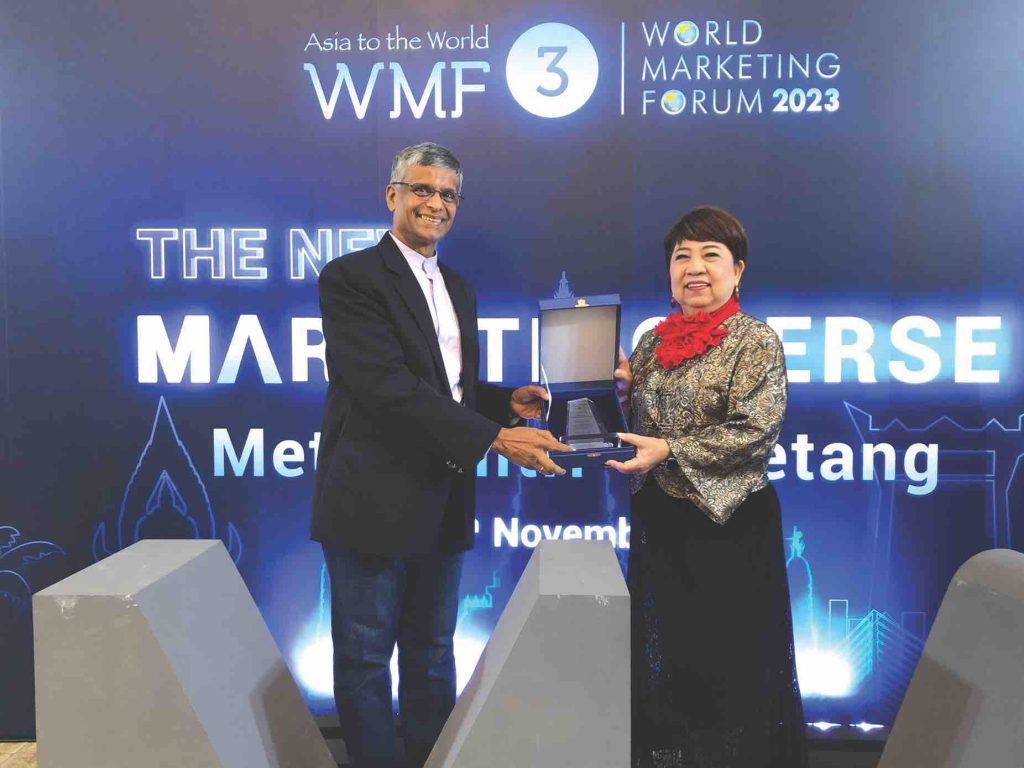
Dr Lackana Leelayouthayotin, Director of Siam Commercial Bank PCL and the former President of AMF presents a memento to Deepal Sooriyaarachchi.
The 3rd World Marketing Forum, organized by the Marketing Association of Thailand in partnership with the Asian Marketing Federation, was held on the 16th and 17th of November, 2023 at the Central Post Office, Bangrak, Bangkok, under the concept of “The New Marketingverse: Meta Mitri Meetang.” The forum featured a dynamic lineup of 20 sessions, spearheaded by 30 eminent business leaders and marketing experts from five continents, including Professor Philip Kotler, Hermawan Kartajaya, and Iwan Setiwan. Who are the three co-authors of the book Marketing 6.0.Eminent professional Deepal Sooriyaarachchi was among the speakers.


